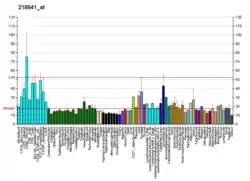FBXW2
F-box/WD repeat-containing protein 2 is a protein that in humans is encoded by the FBXW2 gene.[5][6][7]
| FBXW2 | |||||||||||||||||||||||||
|---|---|---|---|---|---|---|---|---|---|---|---|---|---|---|---|---|---|---|---|---|---|---|---|---|---|
| Identifiers | |||||||||||||||||||||||||
| Aliases | FBXW2, FBW2, Fwd2, Md6, F-box and WD repeat domain containing 2 | ||||||||||||||||||||||||
| External IDs | OMIM: 609071 MGI: 1353435 HomoloGene: 8131 GeneCards: FBXW2 | ||||||||||||||||||||||||
| |||||||||||||||||||||||||
| |||||||||||||||||||||||||
| |||||||||||||||||||||||||
| |||||||||||||||||||||||||
| Orthologs | |||||||||||||||||||||||||
| Species | Human | Mouse | |||||||||||||||||||||||
| Entrez | |||||||||||||||||||||||||
| Ensembl | |||||||||||||||||||||||||
| UniProt | |||||||||||||||||||||||||
| RefSeq (mRNA) |
| ||||||||||||||||||||||||
| RefSeq (protein) |
| ||||||||||||||||||||||||
| Location (UCSC) | Chr 9: 120.75 – 120.79 Mb | Chr 2: 34.8 – 34.83 Mb | |||||||||||||||||||||||
| PubMed search | [3] | [4] | |||||||||||||||||||||||
| Wikidata | |||||||||||||||||||||||||
| |||||||||||||||||||||||||
Function
F-box proteins are an expanding family of eukaryotic proteins characterized by an approximately 40 amino acid motif, the F box. Some F-box proteins have been shown to be critical for the ubiquitin-mediated degradation of cellular regulatory proteins. In fact, F-box proteins are one of the four subunits of ubiquitin protein ligases, called SCFs. SCF ligases bring ubiquitin conjugating enzymes to substrates that are specifically recruited by the different F-box proteins. Mammalian F-box proteins are classified into three groups based on the presence of either WD-40 repeats, leucine-rich repeats, or the presence or absence of other protein-protein interacting domains. This gene encodes the second identified member of the F-box gene family and contains multiple WD-40 repeats.[7]
References
- GRCh38: Ensembl release 89: ENSG00000119402 - Ensembl, May 2017
- GRCm38: Ensembl release 89: ENSMUSG00000035949 - Ensembl, May 2017
- "Human PubMed Reference:". National Center for Biotechnology Information, U.S. National Library of Medicine.
- "Mouse PubMed Reference:". National Center for Biotechnology Information, U.S. National Library of Medicine.
- Cenciarelli C, Chiaur DS, Guardavaccaro D, Parks W, Vidal M, Pagano M (Dec 1999). "Identification of a family of human F-box proteins". Curr Biol. 9 (20): 1177–9. doi:10.1016/S0960-9822(00)80020-2. PMID 10531035. S2CID 7467493.
- Chiaur DS, Murthy S, Cenciarelli C, Parks W, Loda M, Inghirami G, Demetrick D, Pagano M (Jun 2000). "Five human genes encoding F-box proteins: chromosome mapping and analysis in human tumors". Cytogenet Cell Genet. 88 (3–4): 255–8. doi:10.1159/000015532. PMID 10828603. S2CID 431704.
- "Entrez Gene: FBXW2 F-box and WD repeat domain containing 2".
Further reading
- Patton EE, Willems AR, Tyers M (1998). "Combinatorial control in ubiquitin-dependent proteolysis: don't Skp the F-box hypothesis". Trends Genet. 14 (6): 236–43. doi:10.1016/S0168-9525(98)01473-5. PMID 9635407.
- Winston JT, Koepp DM, Zhu C, Elledge SJ, Harper JW (1999). "A family of mammalian F-box proteins". Curr. Biol. 9 (20): 1180–2. doi:10.1016/S0960-9822(00)80021-4. PMID 10531037. S2CID 14341845.
- Busino L, Donzelli M, Chiesa M, Guardavaccaro D, Ganoth D, Dorrello NV, Hershko A, Pagano M, Draetta GF (2003). "Degradation of Cdc25A by beta-TrCP during S phase and in response to DNA damage". Nature. 426 (6962): 87–91. doi:10.1038/nature02082. PMID 14603323. S2CID 768783.
- Watanabe N, Arai H, Nishihara Y, Taniguchi M, Watanabe N, Hunter T, Osada H (2004). "M-phase kinases induce phospho-dependent ubiquitination of somatic Wee1 by SCFβ-TrCP". Proc. Natl. Acad. Sci. U.S.A. 101 (13): 4419–24. doi:10.1073/pnas.0307700101. PMC 384762. PMID 15070733.
- Yang CS, Yu C, Chuang HC, Chang CW, Chang GD, Yao TP, Chen H (2005). "FBW2 targets GCMa to the ubiquitin-proteasome degradation system". J. Biol. Chem. 280 (11): 10083–90. doi:10.1074/jbc.M413986200. PMID 15640526.
- Rual JF, Venkatesan K, Hao T, Hirozane-Kishikawa T, Dricot A, Li N, Berriz GF, Gibbons FD, Dreze M, Ayivi-Guedehoussou N, Klitgord N, Simon C, Boxem M, Milstein S, Rosenberg J, Goldberg DS, Zhang LV, Wong SL, Franklin G, Li S, Albala JS, Lim J, Fraughton C, Llamosas E, Cevik S, Bex C, Lamesch P, Sikorski RS, Vandenhaute J, Zoghbi HY, Smolyar A, Bosak S, Sequerra R, Doucette-Stamm L, Cusick ME, Hill DE, Roth FP, Vidal M (2005). "Towards a proteome-scale map of the human protein-protein interaction network". Nature. 437 (7062): 1173–8. doi:10.1038/nature04209. PMID 16189514. S2CID 4427026.
- Kimura K, Wakamatsu A, Suzuki Y, Ota T, Nishikawa T, Yamashita R, Yamamoto J, Sekine M, Tsuritani K, Wakaguri H, Ishii S, Sugiyama T, Saito K, Isono Y, Irie R, Kushida N, Yoneyama T, Otsuka R, Kanda K, Yokoi T, Kondo H, Wagatsuma M, Murakawa K, Ishida S, Ishibashi T, Takahashi-Fujii A, Tanase T, Nagai K, Kikuchi H, Nakai K, Isogai T, Sugano S (2006). "Diversification of transcriptional modulation: Large-scale identification and characterization of putative alternative promoters of human genes". Genome Res. 16 (1): 55–65. doi:10.1101/gr.4039406. PMC 1356129. PMID 16344560.




